The last resting place of numerous Habsburg emperors and others associated with the dynasty is below a monastic church in Vienna’s centre: the Kapuzinergruft (Imperial Crypt).
- Coffins from the ornate to the ordinary
- Plenty of bronze skulls for those of a Gothic bent
- Chambers are well-lit and airy
- Numerous historical figures buried within
- Book a Viennese concert experience* in a historical venue
- See also:
- Free one-time entry with a Vienna Pass
- Stephansdom catacombs tour
- Michaelerkirche crypt tour
- The Kapuzinerkirche church
- The Habsburgs: a simple introduction
Inside the crypt
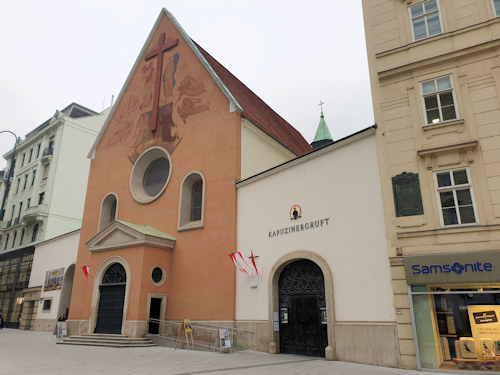
(The church and public crypt entrance)
Those who like to experience raw history should take the time to find the 17th-century Capuchin Monastery (Kapuzinerkloster) and Capuchin church in the very center of Vienna.
The complex houses the Imperial Crypt, known locally as the Kaisergruft or Kapuzinergruft: the last resting place of dozens of Habsburg emperors, empresses, archdukes, archduchesses, their spouses and their offspring; an accumulation of corpses from one of the most famous ruling dynasties in world history.
Inside the crypt, you stand within touching distance of Maximilian I, Emperor of Mexico.
Or Empress Maria Theresa and her husband, Franz Stephan, the Holy Roman Emperor.
Or Emperor Francis II/I, founder of the Austrian Empire.
Or Empress Elisabeth, the iconic Sisi.
…and many (many) more.
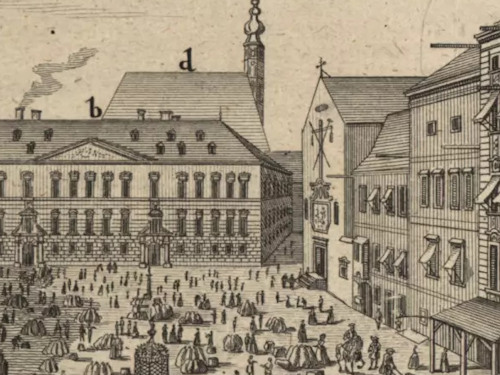
(The church and crypt entrance pictured on the right in a 1724 volume published by Johann Andreas d. Ä. Pfeffel; engraving by Georg Daniel Heumann based on a drawing by Salomon Kleiner; Wien Museum Inv.-Nr. 31113; excerpt reproduced with permission under the terms of the CC0 licence)
Be aware, though, that this is no virtual reality tourist attraction, but the actual family crypt of the imperial line: an underground graveyard, albeit one with a rich history attached.
The Kapuzinergruft is a place of strange contrasts. Prepare for disappointment if you expect a musty, dank, dark experience: the crypt contains a series of large, well-lit and airy chambers. Cool but not cold, making this one of your best options on hot summer days.
The bright, clean surroundings do little, however, to counter the starkness of the place, with its bare walls and row upon row of large ornate sarcophagi.
If you want a more traditional crypt experience, try the Stephansdom cathedral catacombs, which include a mass grave for plague victims. Or the Michaelerkirche crypt tour with its mummies and painted coffins.
A sense of sadness certainly hangs over everything inside the Kapuzinergruft: death as the ultimate leveller.
Despite the wealth, fame, power (and expensive coffin), all that’s left is a body in a box to be stared at by visitors taking hurried snapshots before moving on to beer and sausages.
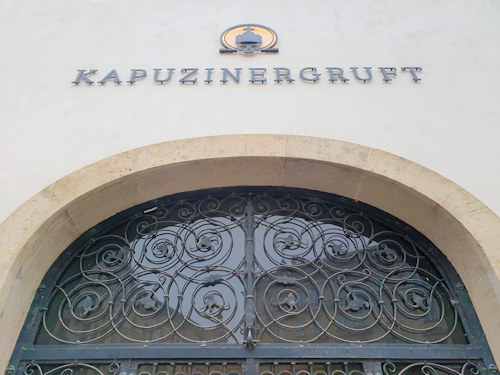
(The intricate entrance gate)
If you don’t linger, you can finish in no more than 30 minutes. But take the time to look closely at the intricate decoration on some of the coffins.
Lead, pewter, bronze or copper materials dominate. They used silver and gold sparingly, not least because visitors would steal bits (humanity never ceases to disappoint.)
Crypt “highlights”
Emperor Karl VI (1685-1740) probably has the most impressive sarcophagus, only because of the quite wonderful crowned skulls and similar decorative motifs.
The most impressive section is the Maria-Theresien-Gruft, a domed chamber dominated by a huge, complex sarcophagus for the Empress Maria Theresa (1717-1780) and Emperor Franz Stephan (1708-1765). The same location houses many of her 16 children.
One of those children is the Empress’s eldest son, who became Emperor Joseph II (1741-1790). With its nondescript copper design, his coffin contrasts remarkably with that of his parents. But then Joseph II was famous for his rationalist approach and distaste for ceremony.
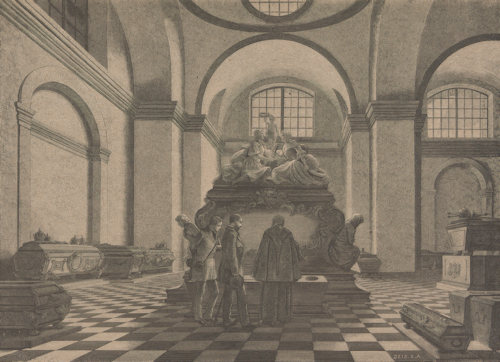
(An 1878 woodcut of part of the crypt by Alois Greil; Wien Museum Inv.-Nr. W 2650; excerpt reproduced with permission under the terms of the CC0 licence)
Another “must-see” is the Franz-Josephs-Gruft, the chamber that’s home to the aforementioned Empress Elisabeth (1837-1898), her husband Emperor Franz Joseph I (1830-1916), and their son Crown Prince Rudolph (1858-1889).
An anarchist assassinated Elisabeth in Switzerland, while Rudolph’s death saw the succession pass to Franz Joseph’s nephew, Franz Ferdinand (whose own assassination in Sarajevo sparked the first World War; see the car he was in at the Heeresgeschichtliches Museum).
No excessive ornamentation graces the last resting place of Franz Joseph and his family, but you’ll almost certainly find flowers left by well-wishers.
Curiously, I found unexpected flowers left at another coffin on my visit: Marie Louise, second wife of Napoleon.
Tickets & visitor tips
At the time of writing, an adult ticket to the Kaisergruft costs €13. Another crypt ticket option is to enter once for free with a Vienna Pass (see a review).
Inside, you might want to buy an English guide and map. The crypt has no significant information displays (though it’s been a while since I visited), just the names of the dead inscribed next to their coffin or on a stone board on a wall.
This is, after all, not a tourist attraction as such, but a burial place that allows visitors.
Incidentally, the aboveground exterior of the church/crypt made an appearance in one of the more famous movies to be filmed in Vienna: The Third Man. The Kaiserquartett string ensemble often holds advent performances in the church as well.
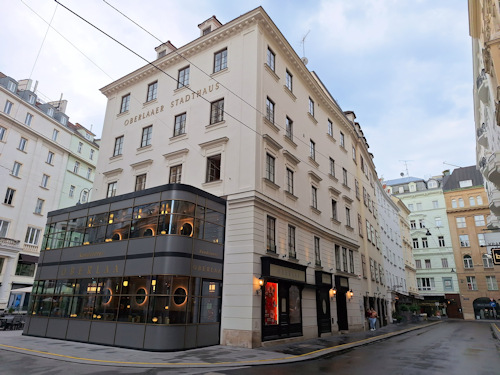
(Nearby Konditorei Oberlaa makes a good place to shake off any lingering crypt-induced melancholy with coffee and cake)
If the crypt experience leaves you in need of a sit down, the Neuer Markt square outside has a branch of Konditorei Oberlaa on it: one of my preferred destinations for coffee in the centre because the service is exceptionally friendly. Sit upstairs in the glassed wing.
Alternatively, relax on the steps of the Donnerbrunnen: an 18th-century fountain unexpectedly free of imperial insignia and religious motifs.
How to find the crypt
Wait for a moonless night. You’ll need wolfsbane and phoenix eggs to complete the opening spell. Alternatively…
The Kapuzinergruft sits among the many historical sights that make up the very centre of Vienna. It’s within shouting (singing?) distance of the State Opera House and close to numerous public transport lines…
Subway: take the U1 and U3 to Stephansplatz or U1, U2 and U4 to Karlsplatz (look for the Oper exit)
Tram/bus: use the the 2A city centre bus and get off at Albertinaplatz
Address: Tegetthoffstraße 2, 1010 Vienna | Website
